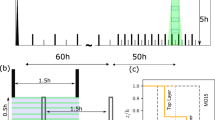Abstract
High-accuracy large-eddy simulations of neutral atmospheric surface-layer flow over a gapped plant canopy strip have been performed. Subgrid-scale (SGS) motions are parameterized by the Sagaut mixed length SGS model, with a modification to compute the SGS characteristic length self-adaptively. Shaw’s plant canopy model, taking the vertical variation of leaf area density into account, is applied to study the response of the atmospheric surface layer to the gapped dense forest strip. Differences in the region far away from the gap and in the middle of the gap are investigated, according to the instantaneous velocity magnitude, the zero-plane displacement, the potential temperature and the streamlines. The large-scale vortex structure, in the form of a roll vortex, is revealed in the region far away from the gap. The nonuniform spatial distribution of plants appears to cause the formation of the coherent structure. The roll vortex starts in the wake of the canopy, and results in strong fluctuations throughout the entire canopy region. Wind sweeps and ejections in the plant canopy are also attributed to the large vortex structure.
Similar content being viewed by others
References
Baldocchi DD, Meyers TP (1988) Turbulence structure in a deciduous forest. Boundary-Layer Meteorol 43: 345–364
Belcher SE, Jerram N, Hunt JCR (2003) Adjustment of a turbulent boundary layer to a canopy of roughness elements. J Fluid Mech 488: 369–398
Businger JA, Wyngaard JC, Izumi Y, Bradley EF (1971) Flux-profile relationships in the atmospheric surface layer. J Atmos Sci 28: 181–189
Dwyer MJ, Patton EG, Shaw RH (1997) Turbulent kinetic energy budgets from a large-eddy simulation of airflow above and within a forest canopy. Boundary-Layer Meteorol 84: 23–43
Ferziger JH (1981) Higher level simulations of turbulent flows. TF-16, Standford Univ.
Finnigan J (2000) Turbulence in plant canopies. Annu Rev Fluid Mech 32: 519–571
Gao W, Shaw RH, Paw UKT (1989) Observation of organized structure in turbulent flow within and above a forest canopy. Boundary-Layer Meteorol 47: 349–377
Hogstrom U, Bergstrom H, Smedman AS, Halldin S, Lindroth A (1989) Turbulent exchange above a pine forest, I: fluxes and gradients. Boundary-Layer Meteorol 49: 197–217
Jiang GS, Shu CW (1996) Efficient implementation of weighted ENO schemes. J Comput Phys 126: 202–228
Lenormand E, Sagaut P, Ta PL, Comte P (2000) Subgrid-scale models for large-eddy simulations of compressible wall bounded flows. AIAA J 38: 1340–1350
Li JC, Xie ZT (1999) Large-eddy simulation for canopy turbulent flow. Acta Mech Sin 31: 406–414
Lilly DK (1967) The representation of small-scale turbulence in numerical simulation experiments. Proceedings of the tenth IBM scientific computing symposium on environmental sciences, IBM Form No. 320–1951, 195–210
Lopes da Costa JC, Castro FA, Palma JMLM, Stuart P (2006) Computer simulation of atmospheric flows over real forests for wind energy resource evaluation. J Wind Eng Ind Aerod 94: 603–620
Metais O, Ferziger JH (1997) New tools in turbulence modelling. Springer, 298 pp
Patton EG, Sullivan PP, Davis KJ (2003) The influence of a forest canopy on top-down and bottom-up diffusion in the planetary boundary layer. Quart J Roy Meteorol Soc 129: 1415–1434
Pope SB (2000) Turbulent flows. Cambridge University Press, UK, 771 pp
Sagaut P (2002) Large eddy simulation for incompressible flows. 2nd edn, Springer, 426 pp
Shaw RH, Hartog GD, Neumann HH (1988) Influence of foliar density and thermal stability on profiles of Reynolds stress and turbulence intensity in a deciduous forest. Boundary-Layer Meteorol 45: 391–409
Shaw RH, Schumann U (1992) Large-eddy simulation of turbulent flow above and within a forest. Boundary-Layer Meteorol 61: 47–64
Smagorinsky J (1963) General circulation experiments with the primitive equations. Mon Wea Rev 91: 99–164
Su HB, Shaw RH, Paw UKT, Moeng CH, Sullivan PP (1998) Turbulent statistics of neutrally stratified flow within and above a sparse forest from large-eddy simulation and field observations. Boundary-Layer Meteorol 88: 363–397
Thom AS (1971) Momentum absorption by vegetation. Quart J Roy Meteorol Soc 97: 414–428
Vreman B, Geurts B, Kuerten H (1997) Large-eddy simulation of the turbulent mixing layer. J Fluid Mech 339: 357–390
Xie ZT, Li JC (2006) A numerical study for turbulent flow and thermal influence over inhomogenous canopy of roughness elements. Environ Fluid Mech 5: 577–597
Author information
Authors and Affiliations
Corresponding author
Rights and permissions
About this article
Cite this article
Qiu, J., Gu, Z.L. & Wang, Z.S. Numerical Study of the Response of an Atmospheric Surface Layer to a Spatially Nonuniform Plant Canopy. Boundary-Layer Meteorol 127, 293–311 (2008). https://doi.org/10.1007/s10546-008-9262-5
Received:
Accepted:
Published:
Issue Date:
DOI: https://doi.org/10.1007/s10546-008-9262-5




